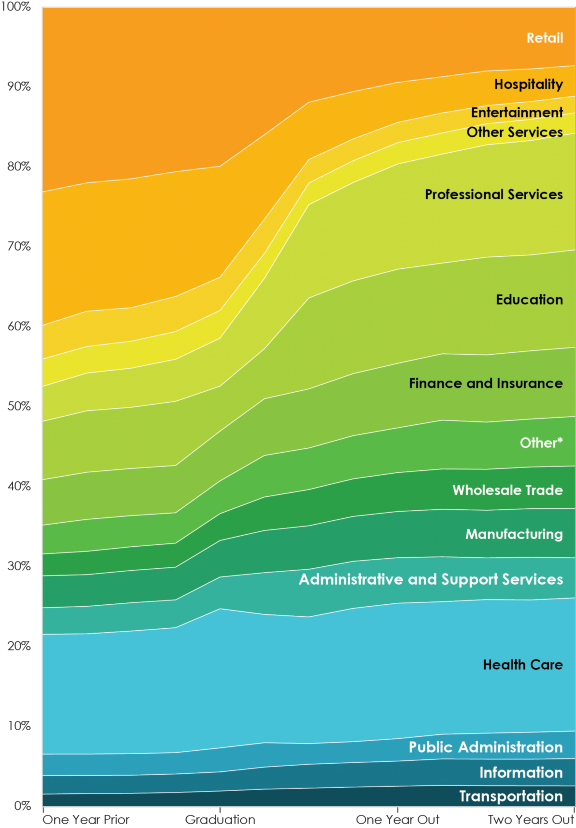![]()
WHERE DO ILLINOIS GRADUATES WORK?
Utilizing information that was obtained in a datasharing partnership with the Illinois Department of Employment Security and the Illinois Student Assistance Commission, researchers from the Illinois Board of Higher Education established the distribution of jobs1 across industrial sectors for bachelor’s degree completers2 from Illinois universities. The distribution was tracked from one year before graduation to two years after graduation. As illustrated in Figure 1, the share of jobs within the retail and hospitality industries shifted dramatically throughout the tracking period. During the timeframe leading up to graduation, roughly two out of every five jobs were either in retail or at restaurants/hotels. This is not all that unexpected given the flexibility in hours and low barriers to entry within those industries, which would make such jobs attractive to college students balancing their studies with work. What is surprising is how rapidly the share of jobs within those industries declines after graduation. In fact, two years after graduation, only 3.8% of the jobs were within accommodation and food services (down from 16.7% one year prior to graduation) and 7.3% were within retail (down from 23.1% one year prior to graduation). The share of jobs within the entertainment sector also declined from 4.2% a year prior to graduation to 2.1% two years after graduation.
In contrast, the share of jobs within professional, scientific, and technical services (which includes firms specializing in accounting, architecture, engineering, and consulting) and the education industries substantially increased. Although 7.3% of jobs were in education a year prior to graduation, jobs within that sector accounted for a 12.2% share two years after graduation. The proportional share of jobs within the professional, scientific, and technical services industry increased from 4.4% a year prior to graduation to 14.6% two years after graduation. Modest proportional increases were also evident in the finance and insurance, wholesale trade, and the manufacturing industries.
The share of jobs within the healthcare industry was relatively large and fairly static throughout the tracking period (between 15% and 17%). Immediately after graduation, as the proportion of jobs within retail and hospitality substantially declined, health care became the industry with the highest share of jobs (16.7%).
So while retail and restaurant jobs were fairly common among college students prior to graduation, the share of jobs within those industries quickly declined and continued to do so the more time that passed after graduation. At the same time, the share of jobs within some of the sectors with higher barriers to entry, such as those requiring a bachelor’s degree and/or professional licensure, significantly increased and continued to increase after graduation.
Figure 1: Industry Job Share for Bachelor’s Degree Completers from Illinois Universities

*Other includes: agriculture; mining; construction; management of companies; real estate; utilities; and unknown.
![]()
-
Jobs are determined by the interaction of a bachelor’s degree completer and a specific employer. Each job requires at least three consecutive quarters of employment.
-
Bachelor’s completers from AY 2013-2014 from nearly all of the MAP-eligible bachelor’s degree granting institutions, public and private alike.
Illinois Board of Higher Education. (November 2018). Where Do Illinois Graduates Work? (IBHE DataPoints 2018-11). Springfield, IL.